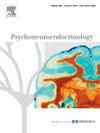Examining cross-lag associations between perceived stress and hair cortisol from pregnancy to 15 months postpartum
IF 3.4
2区 医学
Q2 ENDOCRINOLOGY & METABOLISM
引用次数: 0
Abstract
Background
The perinatal period is often characterized by heightened psychological and biological stress. While psychological distress and neuroendocrine (hypothalamic pituitary adrenal, HPA) activity are often assumed to be interrelated, perceived stress and hair cortisol concentrations, a marker of longer-term HPA activity, are inconsistently associated during the perinatal period. This longitudinal study investigates the concurrent, prospective, and cross-lagged associations between maternal perceived stress and HCC from pregnancy through 15 months postpartum.
Methods
Individuals (n = 304) participated at different points during pregnancy and at 6 weeks, 6 months, and 15 months postpartum. At each time point, self-reported perceived stress and hair samples were collected. Correlational analyses and cross-lagged panel analyses were used to evaluate the stability of perceived stress and hair cortisol over time, as well as the concurrent and cross-lagged associations.
Results
Both perceived stress and HCC showed strong stability across time points. The only significant cross-lagged association was between higher HCC at 6 weeks postpartum predicting higher perceived stress at 6 months. No other cross-lagged or concurrent associations between HCC and perceived stress were significant.
Conclusions
These findings highlight the stability of maternal perceived stress and HCC from pregnancy to 15 months postpartum. We did not find strong support for concurrent or cross-lagged associations between HCC and perceived stress during the perinatal period, suggesting potential distinct biological and psychosocial contributors to psychological and neuroendocrine markers of stress.
检查从怀孕到产后15个月感知压力和头发皮质醇之间的交叉滞后关系
背景围产期通常以心理和生理压力增加为特征。虽然心理困扰和神经内分泌(下丘脑垂体肾上腺素,HPA)活动通常被认为是相互关联的,但感知压力和头发皮质醇浓度(HPA长期活动的标志)在围产期并不一致。这项纵向研究调查了从怀孕到产后15个月期间母亲感知压力与HCC之间的并发、前瞻性和交叉滞后关联。方法在怀孕期间和产后6周、6个月和15个月的不同时间点参与调查的个体(n = 304)。在每个时间点,收集自我报告的感知压力和头发样本。使用相关分析和交叉滞后面板分析来评估感知压力和毛发皮质醇随时间的稳定性,以及并发和交叉滞后的关联。结果感知应激和HCC均表现出较强的跨时间点稳定性。唯一显著的交叉滞后关联是产后6周较高的HCC与产后6个月较高的感知压力之间的关联。HCC与感知压力之间没有其他交叉滞后或同时存在的显著关联。结论这些发现强调了妊娠至产后15个月期间母亲感知应激和HCC的稳定性。我们没有发现肝细胞癌与围产期感知压力之间存在同时或交叉滞后关联的强有力支持,这表明潜在的不同生物学和社会心理因素对心理和神经内分泌压力标志物有影响。
本文章由计算机程序翻译,如有差异,请以英文原文为准。
求助全文
约1分钟内获得全文
求助全文
来源期刊

Psychoneuroendocrinology
医学-精神病学
CiteScore
7.40
自引率
8.10%
发文量
268
审稿时长
66 days
期刊介绍:
Psychoneuroendocrinology publishes papers dealing with the interrelated disciplines of psychology, neurobiology, endocrinology, immunology, neurology, and psychiatry, with an emphasis on multidisciplinary studies aiming at integrating these disciplines in terms of either basic research or clinical implications. One of the main goals is to understand how a variety of psychobiological factors interact in the expression of the stress response as it relates to the development and/or maintenance of neuropsychiatric illnesses.
 求助内容:
求助内容: 应助结果提醒方式:
应助结果提醒方式:


